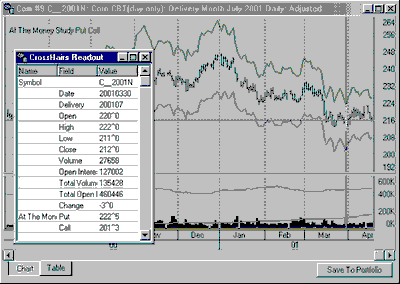 The "At the Money Study" is only available when a raw price series with corresponding options is displayed as a UA chart. This means that the study will not be available for back adjusted, Nth nearest, Perpetual Contract or cash series, and that it is only available to subscribers of the CSI Options database.
The "At the Money Study" is only available when a raw price series with corresponding options is displayed as a UA chart. This means that the study will not be available for back adjusted, Nth nearest, Perpetual Contract or cash series, and that it is only available to subscribers of the CSI Options database.
To view the study, make a chart of the futures, stock or index series that meets these specifications, click the "Indicator" button on the toolbar, and then select "At the Money Study."
Alternately, pull down the Chart menu, click "Study Toolbar" and then select "At the Money Study."
No user input is required, so the study displays as in the following example, which uses the "Tracker" to show numerical data:

Interpretation:
The "At-the-Money" put value (the upper line on the chart) is the sum of the current underlying futures contract, index or stock's closing price plus the premium on the corresponding at-the-money put option.
The "At-the-Money" call value (the lower line on the chart) shows the current underlying futures contract, index or stock's closing price less the premium on the corresponding at-the-money call option.
Together, these two lines show the span of premiums that reveals expected volatility in the given market. This range of premiums is created by the options traders themselves, and is unrelated to any technical or fundamental data.
From the trader's perspective:
Savvy investors know that the option markets provide unique opportunities for both profit and protection. This study helps to illuminate those opportunities. For example, many people bought tech stocks all the way to the top, and then stood helplessly by as their money disappeared on the way down. If they had bought call options instead, their losses would have been limited to the option premium, as opposed the full drop in the stock's price. Depending upon the stock and the specific entry and exit points, the result might have been significantly less red ink. Of course, option trading is not for everyone, as it carries a significant risk of losing money.
Here's an example of how this study might be used. On March 23 of 2000, investors had a choice between buying shares of a Nasdaq Index mutual fund when the Nasdaq was 4660.62 or buying a 4660 April call on the Nasdaq for $301.37. If you bought 100 shares of the fund and dumped them when the index hit 4000, you would have lost roughly $66,000 (the 660 point difference x 100 shares). If, on the other hand, you had purchased the option and let it expire worthless, you would have lost only about $30,000. The loss accrued on the option trade would have been 54% less than the loss would have been on the shares. If, hypothetically, the Nasdaq had gone to zero, the investor would have lost about $466,000 on the shares, but only the same $30,000 on the call -- a 93% reduction in loss. If, however, the Nasdaq had gone up, the value of the call would have increased almost dollar-for-dollar and could have been exercised for nearly a dollar-for-dollar profit.
One could argue that this is not an apples-to-apples comparison. After all, the index fund trader could have put a 301-point stop on the position and had the same result, but that isn't a likely scenario. It was a rare overnight stock trader who actually placed stop orders in March of 2000, and there is nothing that says a stop order would have been executed anywhere near 4299. In fact, the market fell right through 4299 on March 30th, with an intraday low of 4151.12, recovering to close at 4250.19. An unfortunate fill on that day could have left the trader with a sale at the low, and losses of up to $50,950. A comparison of the fund to the option here says the result would have been 69% worse for the fund investor.
That is not to say that stops are useless; just that if the market is willing to sell you an at-the-money call for less then your stop, you can gain peace of mind by converting your soft stop to a hard stop, virtually for free. The costs are just the depreciation in the time-value of the option, and the fact that your call will only gain value dollar-for-dollar once it is deep in the money. Slight gains in the index would be lost to the option trader, but a stop order would retain them because there is no cost associated with the order itself.
There is a time limit on the option, however, so this approach is only suitable for medium- to short-term traders.
If you would like to place a stop closer than what the current at-the-money call is selling for, then you could buy an out-of-the-money call. UA's At the Money Study doesn't address those opportunities. Instead, the At the Money Study shows you what the at-the-money put and call equate to as a stop order. If you are thinking of placing a larger stop, this study helps you evaluate whether an at-the-money option might better meet your needs.